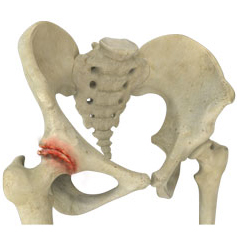Dr. Makda provided EXCEPTIONAL care to my father for his knee replacements.
Dr. Makda provided EXCEPTIONAL care to my father for his knee replacements. His attention to his patients and willingness to explain the treatment pla...

Arthritis is a degenerative condition where the cartilage lining the joints wears out. Cartilage normally serves as a low-friction cushioning that covers the ends of bones. In arthritis, this surface becomes damaged and starts to wear out. When the cartilage wears out, the bone ends rub on one another and cause pain. This condition is referred to as Osteoarthritis or “wear and tear” arthritis, as it occurs with aging and use. It is the most common type of arthritis.
There are numerous conditions that can cause arthritis but often the exact cause is never known.
The causes include:
This article will focus on Osteoarthritis or “wear and tear arthritis” which is the most common type.
The primary symptoms of hip osteoarthritis are pain in the groin, thigh, stiffness, and limited range of motion. In the early stages of osteoarthritis the pain is associated with increased activity such as prolonged walking, kneeling, and going up and down stairs. Often times patients complain about difficulty or inability to put on socks and shoes. As the cartilage wears away, pain can become more severe and constant, interfering with regular daily activities and disrupting sleep.
Doctors diagnose osteoarthritis with a medical history, physical exam and x-rays of the affected joint. During the physical examination your doctor will examine the affected joint for swelling, pain, tenderness, and assess the joint’s range of motion. An X-ray of the hip may show a loss of the joint space and bone spur formation.
There is no blood test for osteoarthritis.

(Left) In this x-ray of a normal hip, the space between the ball and socket indicates healthy cartilage. (Right) This x-ray of an arthritic hip shows severe loss of joint space and bone spurs.
Source: Orthoinfo
There is no known cure for osteoarthritis; however there are several options that can help you ease your pain and symptoms. The treatment of hip osteoarthritis can be categorized as non-surgical and surgical.
Behavioral and lifestyle changes including losing weight and avoiding painful activities and routines can be effective in relieving pain. Oral pain medication such as Acetaminophen (Tylenol) and non-steroidal anti-inflammatory drugs (NSAIDs) such as Ibuprofen or Naproxen can provide relief from pain. Consult with your primary care physician or orthopedic surgeon prior to starting any medications. Physical therapy can improve muscle strength and range of motion, reducing the symptoms of arthritis. Cortisone injections can help to reduce the pain and the swelling of the joint. The non-surgical treatment can be effective but it is unpredictable and only lasts for a short period of time.
When non-surgical treatment is no longer effective and patients are looking for a more permanent solution, hip replacement surgery is the most reliable surgical solution in treating arthritis of the hip. The anterior approach to hip replacement is a minimally invasive technique allowing for a quicker recovery and rehabilitation.
Dr. Makda provided EXCEPTIONAL care to my father for his knee replacements.
Dr. Makda provided EXCEPTIONAL care to my father for his knee replacements. His attention to his patients and willingness to explain the treatment pla...
I had needed knee replacements for quite awhile.
I had needed knee replacements for quite awhile. I even saw other doctors about it but never moved forward as I realized now it all was never explaine...
Dr. Makda is wonderful. He is kind, very knowledgeable and offers different types of recovery for knee problems. After 3 visits I was released from ca...
My left knee was replaced in the hands of Dr Makda last July
My left knee was replaced in the hands of Dr Makda last July. Now my right hip in 2 weeks (mid April 2019).
All went as expected. Have to do all the therapy if you want to recover fast.
All went as expected. Have to do all the therapy if you want to recover fast. Very happy with my new left knee.
100 Village Green Drive
Suite 120
Lincolnshire, IL 60069